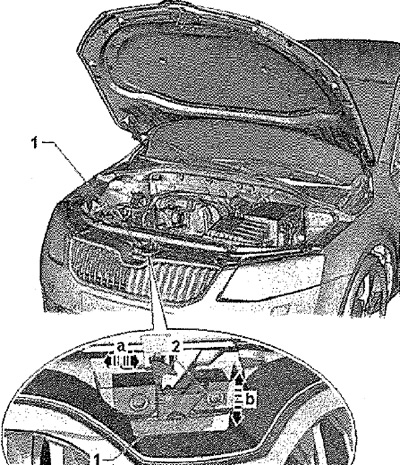Note: To adjust the bonnet, the vehicle must be on a level surface. The adjustable stops -2- on the left and right are not intended for adjustment. They are designed to stabilize or dampen the hood. The hood is correctly adjusted if it blends smoothly into other body panels, is not recessed in or protruding, and has a uniform gap around the entire perimeter. Fixing the hood in the lock should occur without noticeable effort. Do not remove the screws, just loosen them.
Remove the lock bracket -1- by loosening the screws -6- on the bonnet hinges -5- on the left and right, the bonnet can be aligned with the fenders. Make sure the gaps are even.
Adjust installation buffers
Note: Insert buffers -2- on the left and right as far as they will go. If necessary, turn the adjusting buffers by 90°so that there is a slight support at the bonnet cover.
Once the bonnet has been adjusted, the locking clip -1- can be reinstalled and adjusted. The bonnet latch -4- can be used to adjust the height of the front of the bonnet in relation to the front fenders. After the hood is adjusted, the locking bracket is installed and all connections are tightened, the installation buffer can be deployed if necessary. After adjusting work, carry out anti-corrosion treatment of hinges -5- and screws -6-.

Hood lock adjustment

By loosening the screws -2- it is possible to adjust the position of the lock -1- relative to the bonnet in the horizontal plane -arrows a- and in height -arrows b-. Screw tightening torque (pos. 2): 12 Nm.
Lock shackle adjustment

Loosen screws -3-. The bracket -1- can now be adjusted by sliding it in the large holes. Screw tightening torque (pos. 3): 10 Nm.
